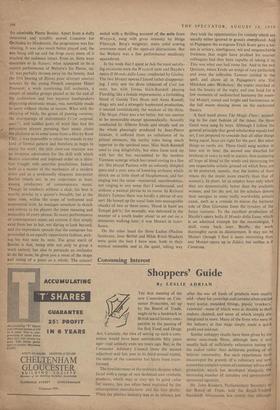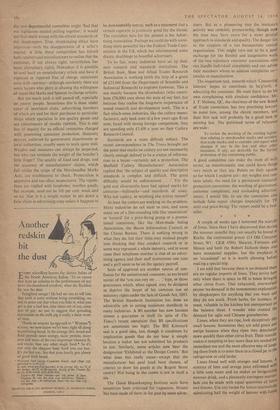Consuming Interest
Shoppers' Guide
By LESLIE ADRIAN THE first meeting of the new Committee on Con- sumer Protection, set up by the Board of Trade, ought to be a landmark in British social history com- parable to the passing of the first Food and Drugs Act. Certainly, the idea of setting up such a com- mittee would have been unthinkable fifty years ago—and unlikely even ten years ago. But, as the Consumer Advisory Council (note the second adjective) said last year in its third annual report, the status of the consumer has lately been trans- formed.
The bewilderment of the ordinary shopper when faced with a range of new technical and synthetic products, which may or may not be good value for money, has too often been exploited by the unscrupulous manufacturer and the lazy dealer. When the plastics industry was in its infancy just after the war all kinds of products were readily sold—sheet for coverings and curtains when textiles were scarce, moulded fittings, plastic 'crockery,' rainwear—none of which were as durable as their makers claimed, and some of which simply dis- integrated in store. Many of the firms who were in the industry at that stage simply made a quick profit and sold out.
Similar unhappy results have been given by the newer man-made fibres, although here it was usually lack of sufficiently exhaustive testing by the maker rather than deliberate pushing of an inferior commodity. But such experiences have encouraged the growth of a voluntary and noW somewhat complex system of consumer advice and protection, which has developed alontside the increasing number of statutory and government- sponsored agencies.
Mr. John Rodgers, Parliamentary Secretary to the Board of Trade, told the Retail-Trading Standards Association last month that although the new departmental committee might 'find that our legislation needed pulling together,' it would not find much wrong with the ethical standards of our shopkeepers. True, shopkeeping ethics have improved—with the disappearance of a seller's market. A little sharp competition has forced both retailers and manufacturers to realise that the customer, if not always right, nevertheless has some elementary rights. Nowadays it is possible to send back an unsatisfactory article and have it replaced or repaired free of charge, sometimes even with courtesy—although inevitably there are some buyers who glory in abusing the willingness of stores like Marks and Spencer to change articles.
But too much junk is still passed off, especially on poorer people, Sometimes this is done under cover of 'provident clubs,' subscribing members of which are tied for their purchases to particular shops which specialise in low-quality goods and are connoisseurs of shoddy rubbish. This is one line of inquiry for an official committee charged with promoting consumer protection. Statutory oevices, enforced by government departments or local authorities, usually seem to work quite well. Weights and measures can always be inspected, but who can estimate the weight of the butcher's little finger? The quality of food and drugs, and the accuracy of manufacturers' claims, which fall within the scope of the Merchandise Marks Acts, are troublesome to check. Prosecution is expensive and too often inconclusive. The regula- tions are riddled with loopholes; woollen goods, for example, need not be 100 per cent. wool, and so on. Nor is it a simple matter to pin down a false claim in advertising copy unless it happens to be demonstrably untrue, such as a statement that a certain cigarette is positively good for the throat.
The custodian here for the present is the Adver- tising Association. Perhaps we could do with some- thing more powerful like the Federal Trade Com- mission in the US, which has administered some drastic drubbings to boastful advertisers.
To be fair, many industries have set up their own research and standards institutions. The British Boot, Shoe and Allied Trades Research Association is working (with the help of a grant of L23,000 from the Department of Scientific and Industrial Research) to improve footwear. This is not merely because the shoemakers (who contri- bute £70,000) care about the state of our feet, but because they realise the long-term importance of sound research and development work. This is a fact which some industries, like the cutlery manu- facturers, only took note of a few years ago. Even now, faced with strong foreign competition, they are spending only £5,400 a year on their Cutlery Research Council.
Standards are a more difficult subject. The recent correspondence in 7'he Times brought .out the point that marks on cutlery are not necessarily clearly enough defined to be a source of informa- tion to a buyer—certainly not a protection. The Sheffield Cutlery Manufacturers' Association replied that 'the subject of quality and descriptive standards is complex and difficult. The great difficulty would be enforcement. . . .' Yet the gold and silversmiths have had agreed marks for centuries—hallmarks—and standards of assay. Why not cutlery, or anything else within reason?
At least the cutlers are working on the problem. Many industries do not seem to care, and some make use of a fine-sounding title like 'association' or 'council' for a price-fixing group or a promo- tional committee, like the Man-made Soling Association, the Bacon Information Council or the Cheese Bureau. There is nothing wrong in what they do, but their titles may mislead people into thinking that they conduct research or in some way represent a whole industry, and in some cases their telephone number is that of an adver- tising agency and their staff (sometimes one man and a girl) seem to be on the agency payroll.
Seals of approval are another source of con- fusion for the uninstructed consumer, as are brand names of the 'you can rely on . . .' type, or those guarantees which, when signed, may be designed to deprive the buyer of his common law or statutory rights under the Sale of Goods Act, 1893. The British Standards Institution has done an admirable job in setting minimum standards in many industries. A BS number has now become almost a guarantee in itself (in spite of The Times's recent complaint that BS specifications are sometimes too high). The BSI Kiternark seal is a good idea, too, though it condemns by implication goods that do not bear it simply because a maker has not submitted his products to test. Similarly, some articles now bear the designation 'Exhibited at the Design Centre.' But what does this really mean—except that the manufacturer has paid (and been chosen, of course) to show his goods at the Regent Street centre? Not being in the centre is not in itself a
sin.
The Good Housekeeping Institute seals have sometimes been criticised for vagueness. Misuse has been made of them in the past by some adver- tisers. But as a pioneering step the institute's activity was certainly praiseworthy, though noW the time may have come for a more general approach to standards and quality. The danger lies in the creation of a too bureaucratic central organisation. This might turn out to be a poor exchange for the flexible and imaginative work of the two voluntary consumer associations who can .handle individual complaints and can advise their members whom to address complaints to-' retailer or manufacturer.
The important task, towards which 'Consuming Interest' hopes to contribute its ha'p'orth, is educating the consumer. He must learn to do his own complaining with absolute confidence. Mr. J. T. Molony, QC, the chairman of the new Board of Trade committee, has two practising lawyers to assist him, among the eleven members, and their first task will probably be a good look at existing law. The published terms of reference are wide :
To review the working of the existing legisla- tion relating to merchandise marks and certifica- tion trade marks, and to consider and report what changes if any in the law and what other measures, if any, are desirable for the further protection of the consuming public.
A good committee can make the most of such terms; an unenthusiastic one could leave things very much as they are. Points on their agenda so far which I endorse arc : net weights and con- tents labels; the need for a permanent consumer protection committee; the wording of guarantees; customer complaints; and misleading advertise- ments. I would like to sec the committee also include false repair charges (especially for TV sets) and price-fixing. The report could be a best- seller.
A couple of weeks ago I lamented the scarcitY of limes. Since then I have discovered that during the summer montH they can usually be found at Roche, the continental grocer (14 Old Compton Street, WI : GER 4588). Shearns, Fortnum and Mason and both the Robert Jackson shops also have occasional supplies, but the emphasis iS on 'occasional' so it is worth phoning before making a special trip.
I am told that because there is no demand there are no regular imports of limes. They arrive here only when there is space to fill in boats bringing other citrus fruits. That exhausted, overworked excuse `no demand' is the monotonous explanation by shopkeepers for anything that you want and they do not stock. Fresh herbs, for instance. or yeast, valuable in the kitchen but unimportant on the balance sheet. I wonder who created the demand for uglis and Chinese gooseberries.
Limes, when they are ripe, look deceptively like small lemons. Sometimes they are sold green and unripe because when they ripen they deteriorate more quickly than other citrus fruit. Their scarcitY makes it tempting to buy more than are needed for immediate use and the most effective way of keel,' ing them fresh is to store them in a closed jar in the refrigerator or cold larder. Limes blend well with oranges and lemons. A mixture of lime and orange juice enlivened wall a little soda water and ice makes an invigorating summer drink, and a pleasantly astringent marina' lade can be made with equal quantities of litres and lemons. Use any recipe for lemon marmalade, substituting half the weight of lemons with lime



































 Previous page
Previous page